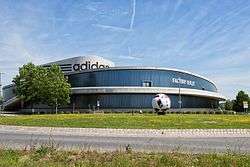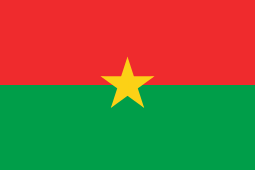Herzogenaurach
Herzogenaurach (German: [hɛʁtsoːɡn̩ˈʔaʊʁax] (![]()
Herzogenaurach | |
|---|---|
 Adidas factory outlet in Herzogenaurach | |
 Coat of arms | |
Location of Herzogenaurach within Erlangen-Höchstadt district  | |
 Herzogenaurach  Herzogenaurach | |
| Coordinates: 49°34′N 10°53′E | |
| Country | Germany |
| State | Bavaria |
| Admin. region | Mittelfranken |
| District | Erlangen-Höchstadt |
| Subdivisions | 12 districts |
| Government | |
| • Mayor | German Hacker (SPD) |
| Area | |
| • Total | 47.60 km2 (18.38 sq mi) |
| Elevation | 301 m (988 ft) |
| Population (2018-12-31)[1] | |
| • Total | 23,126 |
| • Density | 490/km2 (1,300/sq mi) |
| Time zone | CET/CEST (UTC+1/+2) |
| Postal codes | 91074 |
| Dialling codes | 09132 |
| Vehicle registration | ERH |
| Website | www.herzogenaurach.de |

Geography
Herzogenaurach is situated in the Middle Franconia area of Bavaria, approx. 23 km (or 14 miles) northwest of Nuremberg. The town is located on the Aurach river, a tributary of the Regnitz river.
History
Herzogenaurach was first mentioned in a document from 1002 under the name of Uraha when Holy Roman Emperor Henry II granted the town to the Prince-Bishopric of Bamberg.
Economy
Herzogenaurach has gained global fame as the birthplace of two giant sporting goods companies: Adidas and Puma, each founded respectively by brothers Adolf Dassler and Rudolf Dassler, after an acrimonious familial split in 1948. Both companies' headquarters are still located in the town, originally on opposite sides of the Aurach River, and brand loyalty was sharply divided as well. For many years, Adidas and Puma workers would not associate with each other, and even when Adolf and Rudi died, they were buried in opposite ends of the town's cemetery.[4] These differences have cleared up over the years.
Also the headquarters of Schaeffler Group are located in Herzogenaurach.

Sport
Even the town's two football clubs were divided by the Adidas/Puma split: ASV Herzogenaurach was supported by Adidas, while FC Herzogenaurach endorsed Puma's footwear.[5] Both clubs still play at amateur level.
The Argentina national football team were based in Herzogenaurach for the 2006 FIFA World Cup.
Néstor De la Torre, Mexico's Director of National Teams, said the Selección de fútbol de México (Mexico national team) would gather for 12 days in the city, its last stop before heading to South Africa for the 2010 World Cup.
Herzo Base
Herzogenaurach was the location of a military airfield beginning in the 1930s. The airfield was originally designed as an airfield by a French architect and constructed by the Deutsche Luftwaffe (Air Force), named Deutsche Fliegerschule (German pilot school). Initially, the post was limited in its use as a Hitler youth training school due to limitations imposed by the Versailles Treaty after World War I.
However, fighter pilots soon began training in civilian clothing. In March 1936, the Luftwaffe took official control. The airfield was mainly used as a fuelling point for aircraft providing air cover for troops during the invasion of Austria and Czechoslovakia. On 9 November of each year, planes took off from the airfield to fly over the party rallies staged at Zeppelinwiese (Zeppelin Field) in Nuremberg.
During the Western Allied invasion of Germany in April 1945, the United States Third Army seized the airfield. It was designated as ALG R-29. It was first occupied by a transportation unit followed by the USAAF 354th Fighter Group in May. In May 1946, the 2nd Radio Corps took over the installation and renamed it "Herzo Base". In 1947 the base was occupied by the U.S. Army Security Agency up until 1971, when it was replaced by the 210th Field Artillery Group (re-designated as the 210th Field Artillery Brigade on 16 September 1980) which occupied Herzo Base until 1992. Then Herzo Base was included in the base closure plan. On 4 August 1992, the installation was officially returned to the German Government.[6][7][8][9] It has since served as a civilian recreational airfield,[10] with ICAO code EDQH.
International relations
Herzogenaurach is twinned with:





References
- "Fortschreibung des Bevölkerungsstandes". Bayerisches Landesamt für Statistik und Datenverarbeitung (in German). July 2019.
- "The Town that Sibling Rivalry Built, and Divided | Business | DW.DE | 03.07.2006". Dw.de. Retrieved 2015-05-29.
- Hagler, Tom (2006-06-07). "Europe | German feud inspires boots town". News.bbc.co.uk. Retrieved 2015-05-29.
- Hall, Allan (2009-09-22). "Adidas and Puma bury the hatchet after 60 years of brothers' feud after football match". Telegraph. Retrieved 2016-08-18.
- James, Kyle (3 July 2006). "The Town that Sibling Rivalry Built, and Divided". Deutsche Welle.
- "354 Operations Group Fact Sheet, USAFHRA". Afhra.af.mil. Archived from the original on 2013-01-04. Retrieved 2012-11-04.
- Larry Belmont. "USAAF Airfields in the ETO". Skylighters.org. Retrieved 2012-11-04.
- AAF Airfields in France, Belgium, Netherlands, Luxembourg Archived January 6, 2009, at the Wayback Machine
- "Nuremberg Military Community history page". Nbg-mil-com.de. Retrieved 2012-11-04.
- "EDQH: Home". Flugplatz-herzogenaurach.de. Retrieved 2012-11-04.
External links
| Wikimedia Commons has media related to Herzogenaurach. |